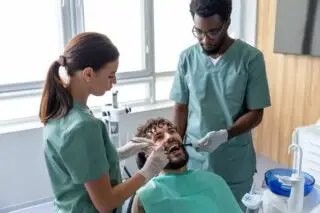Our pets can be the heartbeats of our households. They’re our constant companions and are sometimes even our best, most loyal friends.
So it’s understandable that many animal lovers don’t want to think about their favorite dog or cat ever being in medical peril. But that avoidance is not your friend, says Dr. Aurora Flanagan, a veterinarian who teaches in the Veterinary Technology program at Carrington College’s Citrus Heights campus. In fact, she says, a failure to react quickly can place your sick or injured pet in serious jeopardy.
“I’m a believer in avoiding a crisis whenever possible, and one of the best ways I know to do that is to be prepared,” says Dr. Flanagan, who earned her Doctor of Veterinary Medicine degree from the University of California, Davis, America’s top-rated veterinary school. “When you’re prepared to respond to an emergency, you significantly increase your odds of achieving a successful outcome.”
Dr. Flanagan recommends four simple, easy-to-implement tips that can help you become better prepared:
1: Develop a relationship with a local veterinarian.
Having a veterinarian who knows you and your animal is important, especially in the event your furry friend unexpectedly becomes ill or injured.
“Don’t wait for a problem to occur before creating a connection with a vet you like and trust,” says Dr. Flanagan. “If you don’t currently have a vet, ask friends and neighbors in your area for recommendations. People who know a great vet are usually very happy to recommend them. Make an appointment for a wellness check and establish a medical and vaccination record for your dog or cat. Building a relationship with a veterinary practice is important. And when you’re a regular client, it’ll likely be easier to get an emergency appointment if and when you need one—especially now, when many vets are operating with greater restrictions due to the pandemic.”
2: Anticipate a pet emergency and have a clear plan of action.
If your cat or dog suddenly became ill or injured at 11:00pm on a Saturday night and needed emergency medical care, what would you do and where would you go? It’s important to be able to answer these questions.
“Wasted minutes can make the difference between life and death,” says Dr. Flanagan. “A plan of action is critical. Since many veterinary offices aren’t typically open late at night or on Sundays, it’s always a good idea to know where your nearest 24-hour emergency pet hospital or clinic is located. Ask your vet for a recommendation and store that information in your phone in the event you ever need it.”
3: Be prepared to ask—and answer—essential health questions.
“Animals are creatures of habit, and most of us are very attuned to our pet’s personality, routines and habits,” says Dr. Flanagan. “Sudden changes in their behavior can often be a sign they’re not feeling well and are sick or injured.”
Should you notice any sudden changes in their behavior, Dr. Flanagan says it’s important to answer a few basic health questions:
- Has their breathing pattern changed? Are they breathing more slowly or more rapidly? Are they panting for no apparent reason? Are they breathing with an open mouth?
- Are they walking normally? If they’re walking more slowly than normal or limping, your dog or cat may be injured.
- Does their affect or personality seem different? If a pet who is normally active and playful suddenly becomes listless and lethargic, for example, that can be a sign of illness.
- Are your pet’s gums a healthy pink color? Gum discoloration can be a sign of illness. It’s always good to know what color is normal for your pet so you have a frame of reference should they become ill. Gums that are white, brown or blue can be a sign your pet may need urgent medical attention.
- Is your pet urinating normally? Changes in the frequency of an animal’s elimination habits can be a sign of sickness. If your pet normally urinates two or three times a day and is suddenly going much more frequently, it’s quite likely there’s a medical reason. A trip to the vet can help identify that reason.
4: Become familiar with pet CPR—but perform it only as a last resort.
Performing CPR on a pet in crisis can potentially save his or her life. But if it’s done incorrectly, it can have unintended and even fatal consequences.
“If there’s ever a possibility you might need to perform CPR on an animal, I strongly recommend becoming familiar with the procedure—and the potential dangers and risks—before you consider attempting it,” says Dr. Flanagan. “When an animal is in trouble and adrenaline is pumping in the person who loves that animal, it’s so easy to unintentionally do more harm than good. Sadly, the success rate for animal CPR performed by a person without appropriate medical training is not high.”
That, says Dr. Flanagan, is why she strongly recommends having the names and phone numbers of your veterinarian and a nearby emergency pet hospital stored in your phone’s address book.
While studying online videos that offer demonstrations on performing animal CPR can be helpful in providing basic instructions, Dr. Flanagan say that delaying CPR and rushing your animal to a vet clinic or hospital can be often less damaging than doing CPR incorrectly.
“Animal CPR is a medical procedure, and the odds for success are much higher when it’s performed by a veterinarian or a licensed veterinary technician,” she explains. “Veterinary professionals are highly trained and know how to check airways for breathing obstructions, such as a small toy. They also how to check an animal for a heartbeat and other vital signs, and how to perform chest compressions when it’s medically necessary.”
Awareness, prevention and preparation—such as these straightforward strategies shared by Dr. Flanagan—can help you provide the best possible care for the pet you love.
(The Veterinary Technology program is offered at seven Carrington College campuses in California, including Citrus Heights, Ontario, Pleasant Hill, Sacramento, San Jose, San Leandro and Stockton. Carrington’s Veterinary Assisting program is offered at five locations in Arizona, Oregon and Washington.)



